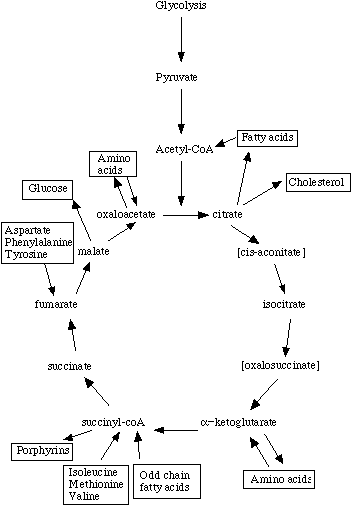
(a) Give a schematic representation of Krebs cycle. List the enzymes involved in each step.
(b) Mention the steps in Krebs cycle in which step NAD and FAD are reduced by accepting hydrogen from different substrates.
Answer
417.1k+ views
Hint: Krebs’s cycle is the process that takes place after the glycolysis or EMP pathway. This process consists of many chemical reactions that convert glucose into the energy. This process is also known as citric acid cycle or tricarboxylic acid.
Complete step by step answer:

Step involved in the Krebs cycle
(1) The condensation takes place. Acetyl group is converted into the citric acid by the reaction with water and fatty acids. The enzyme citrate synthase is used for the catalyzation.
(2) The citric acid obtained from the previous step is converted into isocitrate
(3) Then the next two process is the decarboxylation which yield ketoglutaric acid and succinyl-coA
(4) The succinyl-coA converts into succinic acid in which one molecule of GTP is produced.
(5) In the next reaction ATP is produced from the ADP and NAD is reduced to NADH and FAD is reduced to FADH.
(6) Then the acetic acid is converted to oxaloacetate which is again converted into citrate and hence the process is repeated.
(a) The enzymes involved in the Krebs cycle are citrate synthase, Aconitase, isocitrate dehydrogenase, ketoglutarate dehydrogenase, succinyl coenzyme A synthetase, succinate dehydrogenase, fumarase and malate dehydrogenase.
(b) In the third step of the citric acid cycle in which the citrate is converted to ketoglutarate, NAD is reduced to NADH. And in the fourth step where ketoglutarate is converted into succinyl-coA in which FAD is reduced to FADH. In the last step of the Krebs’s cycle NAD is converted into NADH.
So, the correct answer is “Option B”.
Note:
This Krebs’s cycle or citric acid cycle takes place two times for each molecule of the glucose and it is the cycle of closed loop. In eukaryotes it takes place in mitochondria where in prokaryotes it takes place in the cytoplasm of the cell.
Complete step by step answer:

Step involved in the Krebs cycle
(1) The condensation takes place. Acetyl group is converted into the citric acid by the reaction with water and fatty acids. The enzyme citrate synthase is used for the catalyzation.
(2) The citric acid obtained from the previous step is converted into isocitrate
(3) Then the next two process is the decarboxylation which yield ketoglutaric acid and succinyl-coA
(4) The succinyl-coA converts into succinic acid in which one molecule of GTP is produced.
(5) In the next reaction ATP is produced from the ADP and NAD is reduced to NADH and FAD is reduced to FADH.
(6) Then the acetic acid is converted to oxaloacetate which is again converted into citrate and hence the process is repeated.
(a) The enzymes involved in the Krebs cycle are citrate synthase, Aconitase, isocitrate dehydrogenase, ketoglutarate dehydrogenase, succinyl coenzyme A synthetase, succinate dehydrogenase, fumarase and malate dehydrogenase.
(b) In the third step of the citric acid cycle in which the citrate is converted to ketoglutarate, NAD is reduced to NADH. And in the fourth step where ketoglutarate is converted into succinyl-coA in which FAD is reduced to FADH. In the last step of the Krebs’s cycle NAD is converted into NADH.
So, the correct answer is “Option B”.
Note:
This Krebs’s cycle or citric acid cycle takes place two times for each molecule of the glucose and it is the cycle of closed loop. In eukaryotes it takes place in mitochondria where in prokaryotes it takes place in the cytoplasm of the cell.
Recently Updated Pages
Master Class 11 Economics: Engaging Questions & Answers for Success

Master Class 11 Business Studies: Engaging Questions & Answers for Success

Master Class 11 Accountancy: Engaging Questions & Answers for Success

The correct geometry and hybridization for XeF4 are class 11 chemistry CBSE

Water softening by Clarks process uses ACalcium bicarbonate class 11 chemistry CBSE

With reference to graphite and diamond which of the class 11 chemistry CBSE

Trending doubts
What are the elders in Goa nostalgic about class 11 social science CBSE

Define least count of vernier callipers How do you class 11 physics CBSE

Write the differences between monocot plants and dicot class 11 biology CBSE

Which of the following is not a feature of the election class 11 social science CBSE

The mass of oxalic acid crystals H2C2O42H2O required class 11 chemistry CBSE

How many squares are there in a chess board A 1296 class 11 maths CBSE




